Impact of Immigration Policies on Engineering Education in Australia
VerifiedAdded on 2021/06/17
|18
|4099
|32
Project
AI Summary
This project proposal investigates the impact of Australian immigration policies on engineering education, focusing on the flow of international students. The research explores the evolution of these policies, particularly during the Rudd-Gillard and Abbott governments, and their effects on engineering student enrollment. It aims to answer research questions concerning policy structures, changes, and their influence on student migration. The methodology includes a literature review, comparison of policies, and analysis of student flows. The project justifies the importance of international students to the Australian economy and provides recommendations for shaping immigration policies to encourage foreign students. The expected outcome is an understanding of how policy provisions affect the influx of international engineering students and insights for future policy development.
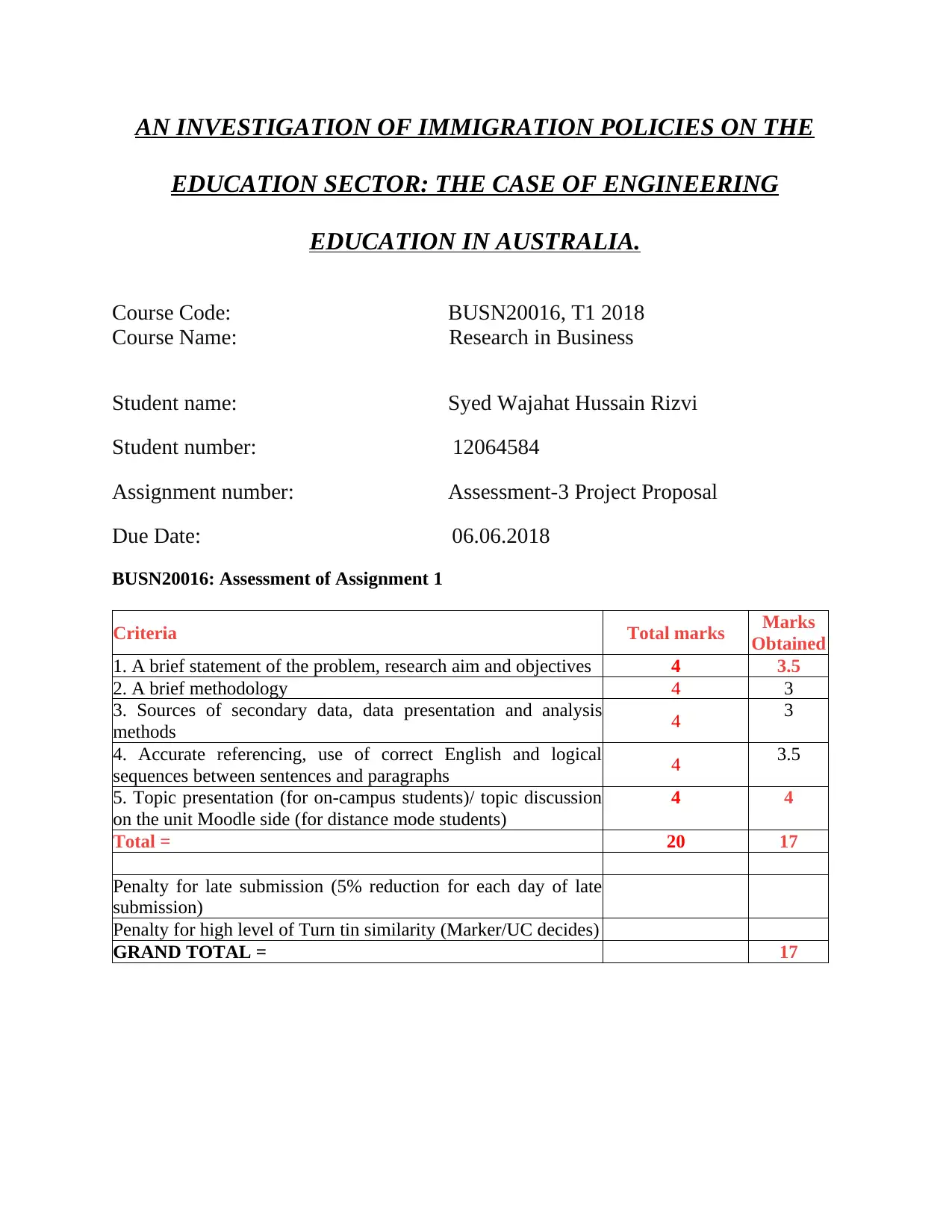
AN INVESTIGATION OF IMMIGRATION POLICIES ON THE
EDUCATION SECTOR: THE CASE OF ENGINEERING
EDUCATION IN AUSTRALIA.
Course Code: BUSN20016, T1 2018
Course Name: Research in Business
Student name: Syed Wajahat Hussain Rizvi
Student number: 12064584
Assignment number: Assessment-3 Project Proposal
Due Date: 06.06.2018
BUSN20016: Assessment of Assignment 1
Criteria Total marks Marks
Obtained
1. A brief statement of the problem, research aim and objectives 4 3.5
2. A brief methodology 4 3
3. Sources of secondary data, data presentation and analysis
methods 4 3
4. Accurate referencing, use of correct English and logical
sequences between sentences and paragraphs 4 3.5
5. Topic presentation (for on-campus students)/ topic discussion
on the unit Moodle side (for distance mode students)
4 4
Total = 20 17
Penalty for late submission (5% reduction for each day of late
submission)
Penalty for high level of Turn tin similarity (Marker/UC decides)
GRAND TOTAL = 17
EDUCATION SECTOR: THE CASE OF ENGINEERING
EDUCATION IN AUSTRALIA.
Course Code: BUSN20016, T1 2018
Course Name: Research in Business
Student name: Syed Wajahat Hussain Rizvi
Student number: 12064584
Assignment number: Assessment-3 Project Proposal
Due Date: 06.06.2018
BUSN20016: Assessment of Assignment 1
Criteria Total marks Marks
Obtained
1. A brief statement of the problem, research aim and objectives 4 3.5
2. A brief methodology 4 3
3. Sources of secondary data, data presentation and analysis
methods 4 3
4. Accurate referencing, use of correct English and logical
sequences between sentences and paragraphs 4 3.5
5. Topic presentation (for on-campus students)/ topic discussion
on the unit Moodle side (for distance mode students)
4 4
Total = 20 17
Penalty for late submission (5% reduction for each day of late
submission)
Penalty for high level of Turn tin similarity (Marker/UC decides)
GRAND TOTAL = 17
Paraphrase This Document
Need a fresh take? Get an instant paraphrase of this document with our AI Paraphraser
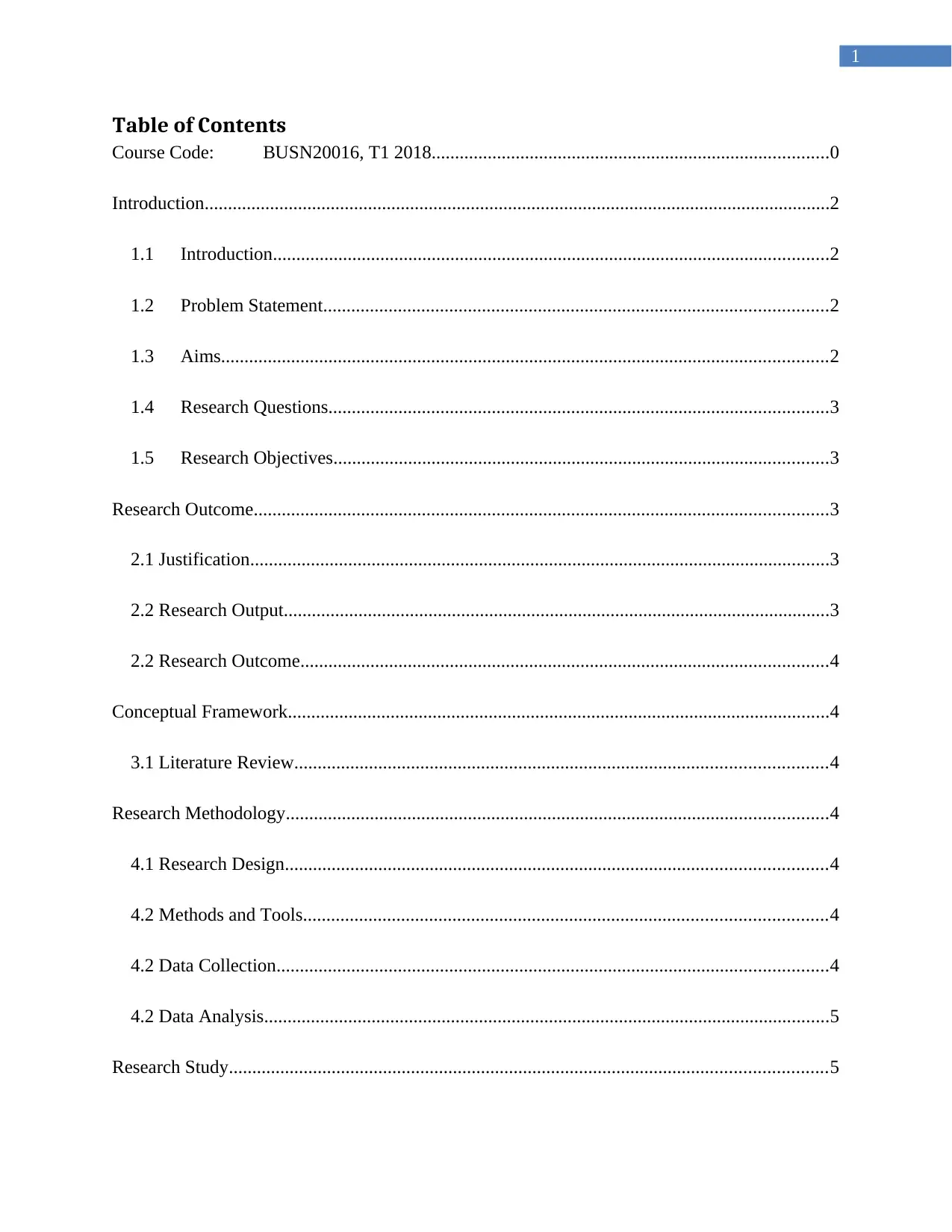
1
Table of Contents
Course Code: BUSN20016, T1 2018.....................................................................................0
Introduction......................................................................................................................................2
1.1 Introduction.......................................................................................................................2
1.2 Problem Statement............................................................................................................2
1.3 Aims..................................................................................................................................2
1.4 Research Questions...........................................................................................................3
1.5 Research Objectives..........................................................................................................3
Research Outcome...........................................................................................................................3
2.1 Justification............................................................................................................................3
2.2 Research Output.....................................................................................................................3
2.2 Research Outcome.................................................................................................................4
Conceptual Framework....................................................................................................................4
3.1 Literature Review..................................................................................................................4
Research Methodology....................................................................................................................4
4.1 Research Design....................................................................................................................4
4.2 Methods and Tools................................................................................................................4
4.2 Data Collection......................................................................................................................4
4.2 Data Analysis.........................................................................................................................5
Research Study................................................................................................................................5
Table of Contents
Course Code: BUSN20016, T1 2018.....................................................................................0
Introduction......................................................................................................................................2
1.1 Introduction.......................................................................................................................2
1.2 Problem Statement............................................................................................................2
1.3 Aims..................................................................................................................................2
1.4 Research Questions...........................................................................................................3
1.5 Research Objectives..........................................................................................................3
Research Outcome...........................................................................................................................3
2.1 Justification............................................................................................................................3
2.2 Research Output.....................................................................................................................3
2.2 Research Outcome.................................................................................................................4
Conceptual Framework....................................................................................................................4
3.1 Literature Review..................................................................................................................4
Research Methodology....................................................................................................................4
4.1 Research Design....................................................................................................................4
4.2 Methods and Tools................................................................................................................4
4.2 Data Collection......................................................................................................................4
4.2 Data Analysis.........................................................................................................................5
Research Study................................................................................................................................5
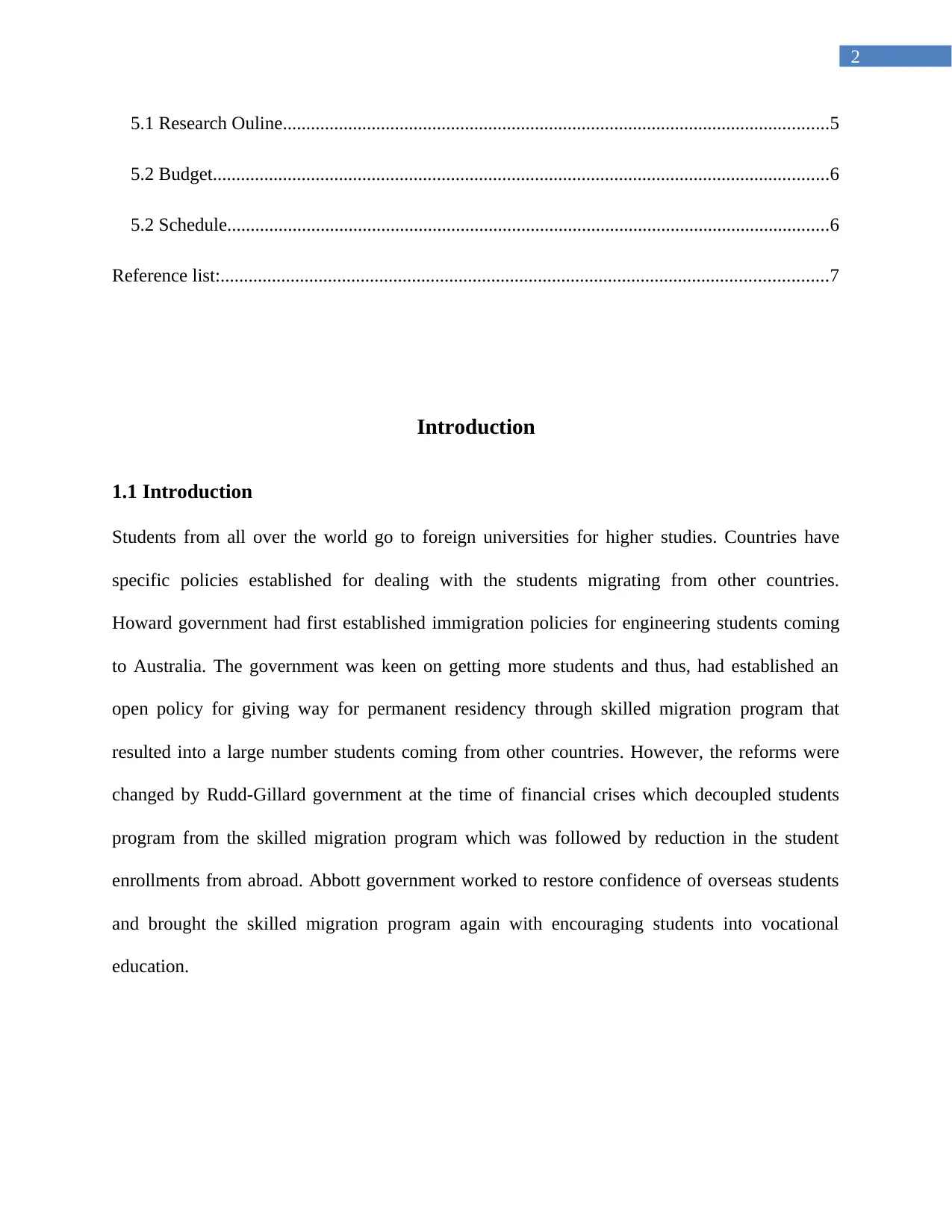
2
5.1 Research Ouline.....................................................................................................................5
5.2 Budget....................................................................................................................................6
5.2 Schedule.................................................................................................................................6
Reference list:..................................................................................................................................7
Introduction
1.1 Introduction
Students from all over the world go to foreign universities for higher studies. Countries have
specific policies established for dealing with the students migrating from other countries.
Howard government had first established immigration policies for engineering students coming
to Australia. The government was keen on getting more students and thus, had established an
open policy for giving way for permanent residency through skilled migration program that
resulted into a large number students coming from other countries. However, the reforms were
changed by Rudd-Gillard government at the time of financial crises which decoupled students
program from the skilled migration program which was followed by reduction in the student
enrollments from abroad. Abbott government worked to restore confidence of overseas students
and brought the skilled migration program again with encouraging students into vocational
education.
5.1 Research Ouline.....................................................................................................................5
5.2 Budget....................................................................................................................................6
5.2 Schedule.................................................................................................................................6
Reference list:..................................................................................................................................7
Introduction
1.1 Introduction
Students from all over the world go to foreign universities for higher studies. Countries have
specific policies established for dealing with the students migrating from other countries.
Howard government had first established immigration policies for engineering students coming
to Australia. The government was keen on getting more students and thus, had established an
open policy for giving way for permanent residency through skilled migration program that
resulted into a large number students coming from other countries. However, the reforms were
changed by Rudd-Gillard government at the time of financial crises which decoupled students
program from the skilled migration program which was followed by reduction in the student
enrollments from abroad. Abbott government worked to restore confidence of overseas students
and brought the skilled migration program again with encouraging students into vocational
education.
⊘ This is a preview!⊘
Do you want full access?
Subscribe today to unlock all pages.

Trusted by 1+ million students worldwide
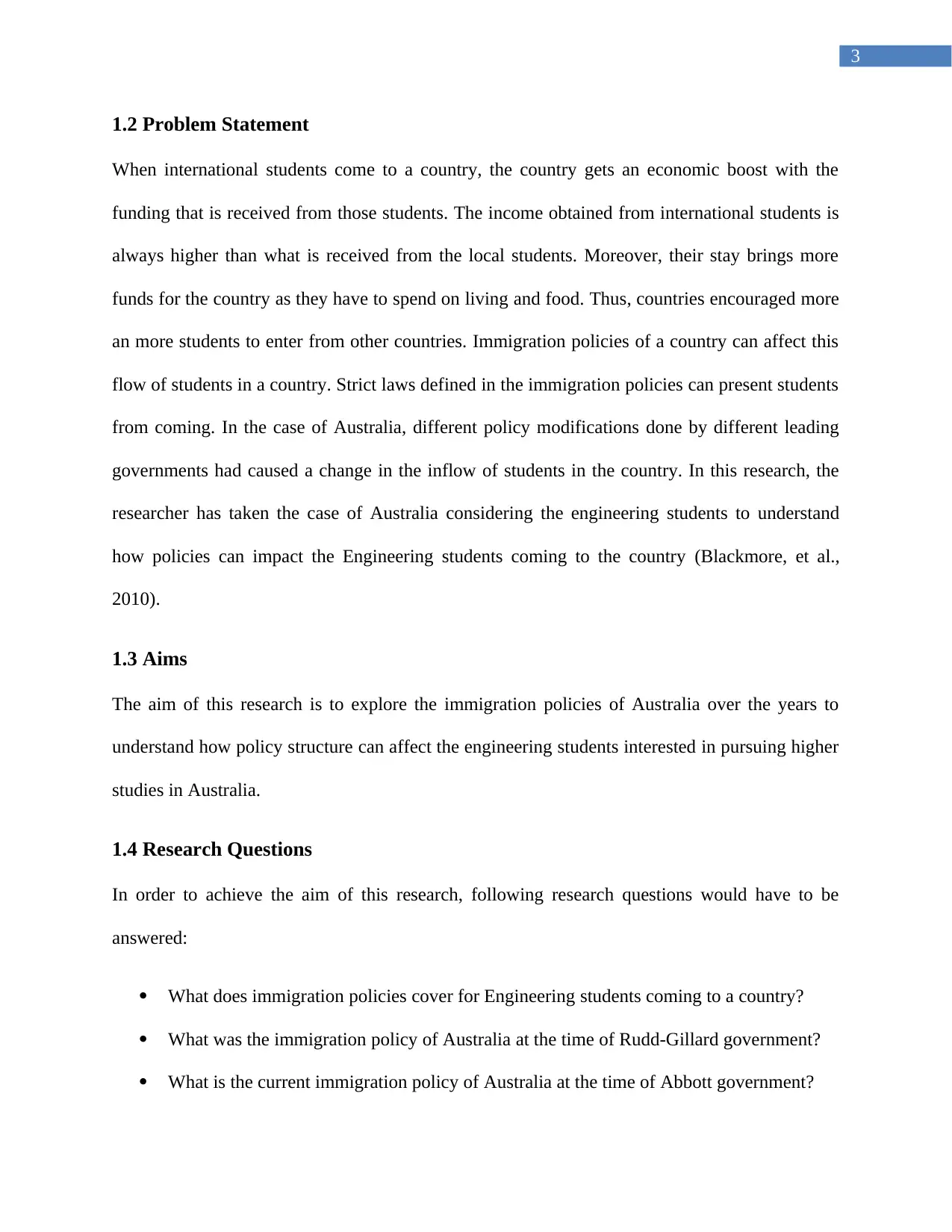
3
1.2 Problem Statement
When international students come to a country, the country gets an economic boost with the
funding that is received from those students. The income obtained from international students is
always higher than what is received from the local students. Moreover, their stay brings more
funds for the country as they have to spend on living and food. Thus, countries encouraged more
an more students to enter from other countries. Immigration policies of a country can affect this
flow of students in a country. Strict laws defined in the immigration policies can present students
from coming. In the case of Australia, different policy modifications done by different leading
governments had caused a change in the inflow of students in the country. In this research, the
researcher has taken the case of Australia considering the engineering students to understand
how policies can impact the Engineering students coming to the country (Blackmore, et al.,
2010).
1.3 Aims
The aim of this research is to explore the immigration policies of Australia over the years to
understand how policy structure can affect the engineering students interested in pursuing higher
studies in Australia.
1.4 Research Questions
In order to achieve the aim of this research, following research questions would have to be
answered:
What does immigration policies cover for Engineering students coming to a country?
What was the immigration policy of Australia at the time of Rudd-Gillard government?
What is the current immigration policy of Australia at the time of Abbott government?
1.2 Problem Statement
When international students come to a country, the country gets an economic boost with the
funding that is received from those students. The income obtained from international students is
always higher than what is received from the local students. Moreover, their stay brings more
funds for the country as they have to spend on living and food. Thus, countries encouraged more
an more students to enter from other countries. Immigration policies of a country can affect this
flow of students in a country. Strict laws defined in the immigration policies can present students
from coming. In the case of Australia, different policy modifications done by different leading
governments had caused a change in the inflow of students in the country. In this research, the
researcher has taken the case of Australia considering the engineering students to understand
how policies can impact the Engineering students coming to the country (Blackmore, et al.,
2010).
1.3 Aims
The aim of this research is to explore the immigration policies of Australia over the years to
understand how policy structure can affect the engineering students interested in pursuing higher
studies in Australia.
1.4 Research Questions
In order to achieve the aim of this research, following research questions would have to be
answered:
What does immigration policies cover for Engineering students coming to a country?
What was the immigration policy of Australia at the time of Rudd-Gillard government?
What is the current immigration policy of Australia at the time of Abbott government?
Paraphrase This Document
Need a fresh take? Get an instant paraphrase of this document with our AI Paraphraser
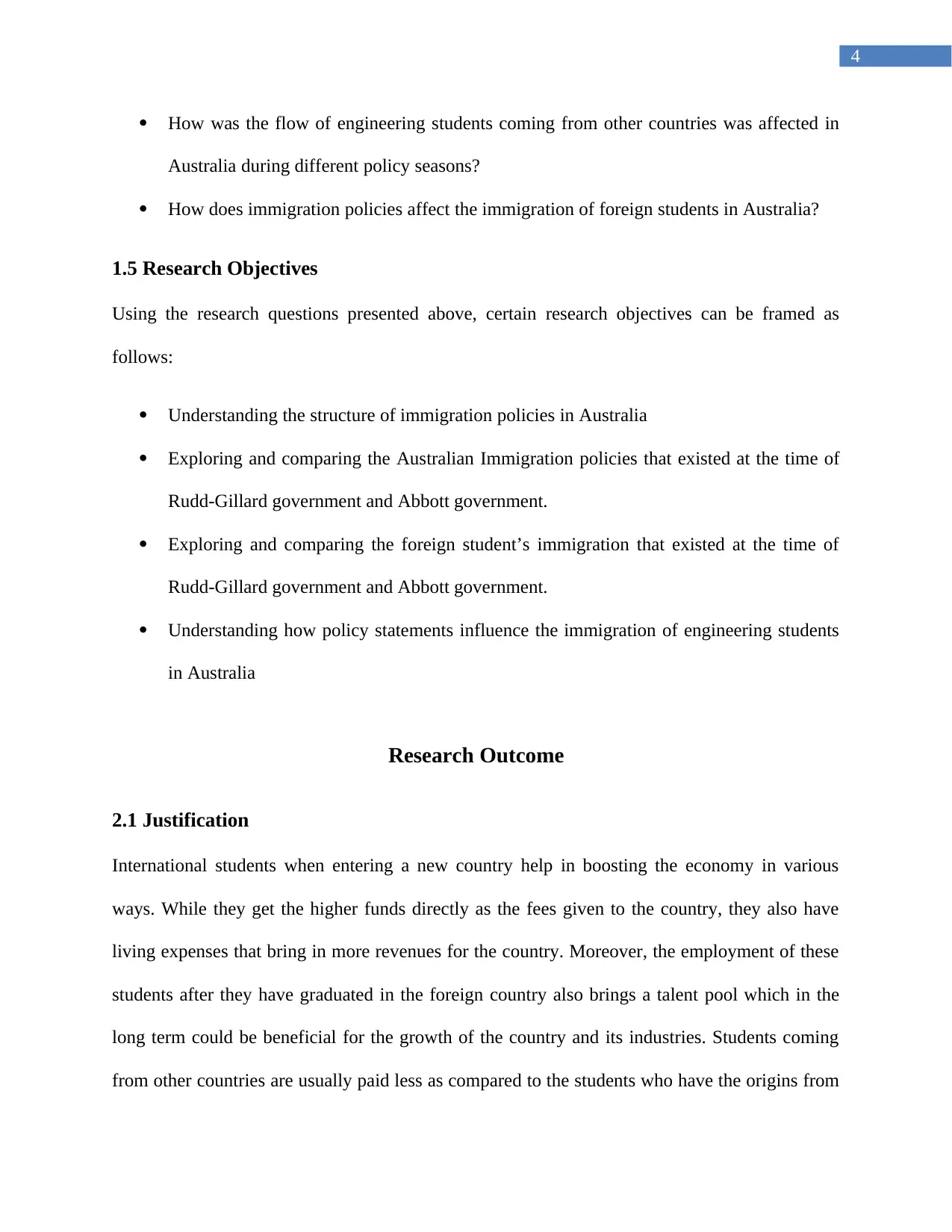
4
How was the flow of engineering students coming from other countries was affected in
Australia during different policy seasons?
How does immigration policies affect the immigration of foreign students in Australia?
1.5 Research Objectives
Using the research questions presented above, certain research objectives can be framed as
follows:
Understanding the structure of immigration policies in Australia
Exploring and comparing the Australian Immigration policies that existed at the time of
Rudd-Gillard government and Abbott government.
Exploring and comparing the foreign student’s immigration that existed at the time of
Rudd-Gillard government and Abbott government.
Understanding how policy statements influence the immigration of engineering students
in Australia
Research Outcome
2.1 Justification
International students when entering a new country help in boosting the economy in various
ways. While they get the higher funds directly as the fees given to the country, they also have
living expenses that bring in more revenues for the country. Moreover, the employment of these
students after they have graduated in the foreign country also brings a talent pool which in the
long term could be beneficial for the growth of the country and its industries. Students coming
from other countries are usually paid less as compared to the students who have the origins from
How was the flow of engineering students coming from other countries was affected in
Australia during different policy seasons?
How does immigration policies affect the immigration of foreign students in Australia?
1.5 Research Objectives
Using the research questions presented above, certain research objectives can be framed as
follows:
Understanding the structure of immigration policies in Australia
Exploring and comparing the Australian Immigration policies that existed at the time of
Rudd-Gillard government and Abbott government.
Exploring and comparing the foreign student’s immigration that existed at the time of
Rudd-Gillard government and Abbott government.
Understanding how policy statements influence the immigration of engineering students
in Australia
Research Outcome
2.1 Justification
International students when entering a new country help in boosting the economy in various
ways. While they get the higher funds directly as the fees given to the country, they also have
living expenses that bring in more revenues for the country. Moreover, the employment of these
students after they have graduated in the foreign country also brings a talent pool which in the
long term could be beneficial for the growth of the country and its industries. Students coming
from other countries are usually paid less as compared to the students who have the origins from
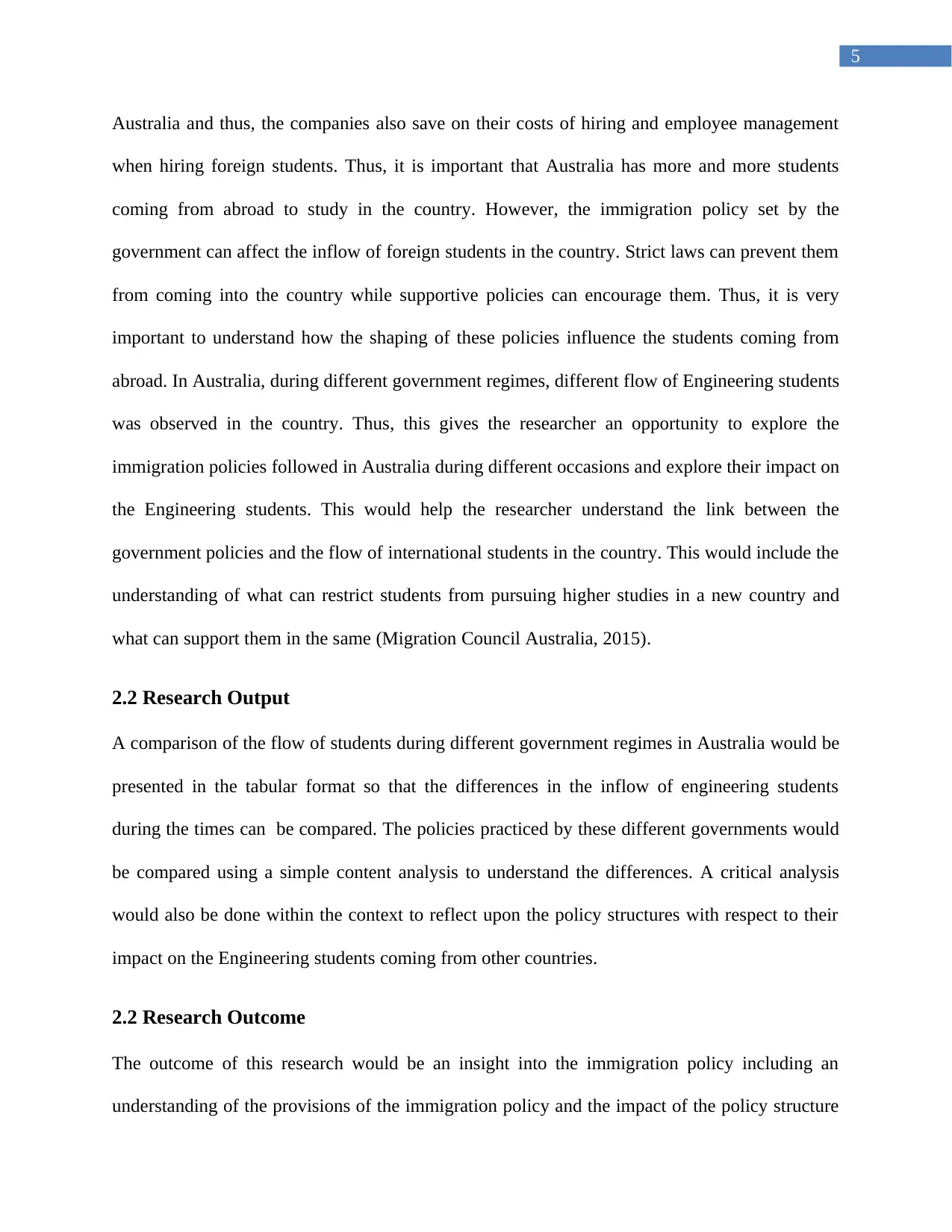
5
Australia and thus, the companies also save on their costs of hiring and employee management
when hiring foreign students. Thus, it is important that Australia has more and more students
coming from abroad to study in the country. However, the immigration policy set by the
government can affect the inflow of foreign students in the country. Strict laws can prevent them
from coming into the country while supportive policies can encourage them. Thus, it is very
important to understand how the shaping of these policies influence the students coming from
abroad. In Australia, during different government regimes, different flow of Engineering students
was observed in the country. Thus, this gives the researcher an opportunity to explore the
immigration policies followed in Australia during different occasions and explore their impact on
the Engineering students. This would help the researcher understand the link between the
government policies and the flow of international students in the country. This would include the
understanding of what can restrict students from pursuing higher studies in a new country and
what can support them in the same (Migration Council Australia, 2015).
2.2 Research Output
A comparison of the flow of students during different government regimes in Australia would be
presented in the tabular format so that the differences in the inflow of engineering students
during the times can be compared. The policies practiced by these different governments would
be compared using a simple content analysis to understand the differences. A critical analysis
would also be done within the context to reflect upon the policy structures with respect to their
impact on the Engineering students coming from other countries.
2.2 Research Outcome
The outcome of this research would be an insight into the immigration policy including an
understanding of the provisions of the immigration policy and the impact of the policy structure
Australia and thus, the companies also save on their costs of hiring and employee management
when hiring foreign students. Thus, it is important that Australia has more and more students
coming from abroad to study in the country. However, the immigration policy set by the
government can affect the inflow of foreign students in the country. Strict laws can prevent them
from coming into the country while supportive policies can encourage them. Thus, it is very
important to understand how the shaping of these policies influence the students coming from
abroad. In Australia, during different government regimes, different flow of Engineering students
was observed in the country. Thus, this gives the researcher an opportunity to explore the
immigration policies followed in Australia during different occasions and explore their impact on
the Engineering students. This would help the researcher understand the link between the
government policies and the flow of international students in the country. This would include the
understanding of what can restrict students from pursuing higher studies in a new country and
what can support them in the same (Migration Council Australia, 2015).
2.2 Research Output
A comparison of the flow of students during different government regimes in Australia would be
presented in the tabular format so that the differences in the inflow of engineering students
during the times can be compared. The policies practiced by these different governments would
be compared using a simple content analysis to understand the differences. A critical analysis
would also be done within the context to reflect upon the policy structures with respect to their
impact on the Engineering students coming from other countries.
2.2 Research Outcome
The outcome of this research would be an insight into the immigration policy including an
understanding of the provisions of the immigration policy and the impact of the policy structure
⊘ This is a preview!⊘
Do you want full access?
Subscribe today to unlock all pages.

Trusted by 1+ million students worldwide
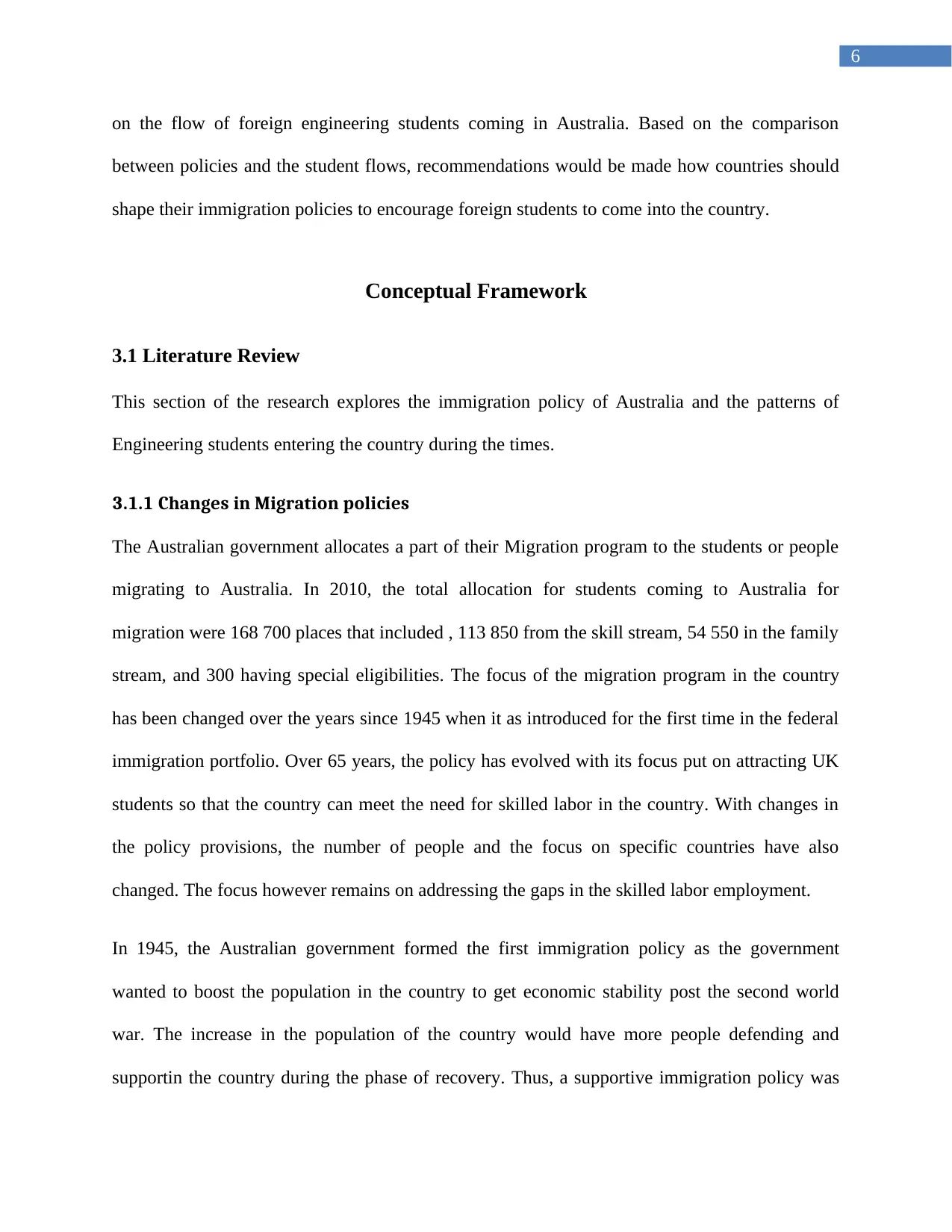
6
on the flow of foreign engineering students coming in Australia. Based on the comparison
between policies and the student flows, recommendations would be made how countries should
shape their immigration policies to encourage foreign students to come into the country.
Conceptual Framework
3.1 Literature Review
This section of the research explores the immigration policy of Australia and the patterns of
Engineering students entering the country during the times.
3.1.1 Changes in Migration policies
The Australian government allocates a part of their Migration program to the students or people
migrating to Australia. In 2010, the total allocation for students coming to Australia for
migration were 168 700 places that included , 113 850 from the skill stream, 54 550 in the family
stream, and 300 having special eligibilities. The focus of the migration program in the country
has been changed over the years since 1945 when it as introduced for the first time in the federal
immigration portfolio. Over 65 years, the policy has evolved with its focus put on attracting UK
students so that the country can meet the need for skilled labor in the country. With changes in
the policy provisions, the number of people and the focus on specific countries have also
changed. The focus however remains on addressing the gaps in the skilled labor employment.
In 1945, the Australian government formed the first immigration policy as the government
wanted to boost the population in the country to get economic stability post the second world
war. The increase in the population of the country would have more people defending and
supportin the country during the phase of recovery. Thus, a supportive immigration policy was
on the flow of foreign engineering students coming in Australia. Based on the comparison
between policies and the student flows, recommendations would be made how countries should
shape their immigration policies to encourage foreign students to come into the country.
Conceptual Framework
3.1 Literature Review
This section of the research explores the immigration policy of Australia and the patterns of
Engineering students entering the country during the times.
3.1.1 Changes in Migration policies
The Australian government allocates a part of their Migration program to the students or people
migrating to Australia. In 2010, the total allocation for students coming to Australia for
migration were 168 700 places that included , 113 850 from the skill stream, 54 550 in the family
stream, and 300 having special eligibilities. The focus of the migration program in the country
has been changed over the years since 1945 when it as introduced for the first time in the federal
immigration portfolio. Over 65 years, the policy has evolved with its focus put on attracting UK
students so that the country can meet the need for skilled labor in the country. With changes in
the policy provisions, the number of people and the focus on specific countries have also
changed. The focus however remains on addressing the gaps in the skilled labor employment.
In 1945, the Australian government formed the first immigration policy as the government
wanted to boost the population in the country to get economic stability post the second world
war. The increase in the population of the country would have more people defending and
supportin the country during the phase of recovery. Thus, a supportive immigration policy was
Paraphrase This Document
Need a fresh take? Get an instant paraphrase of this document with our AI Paraphraser
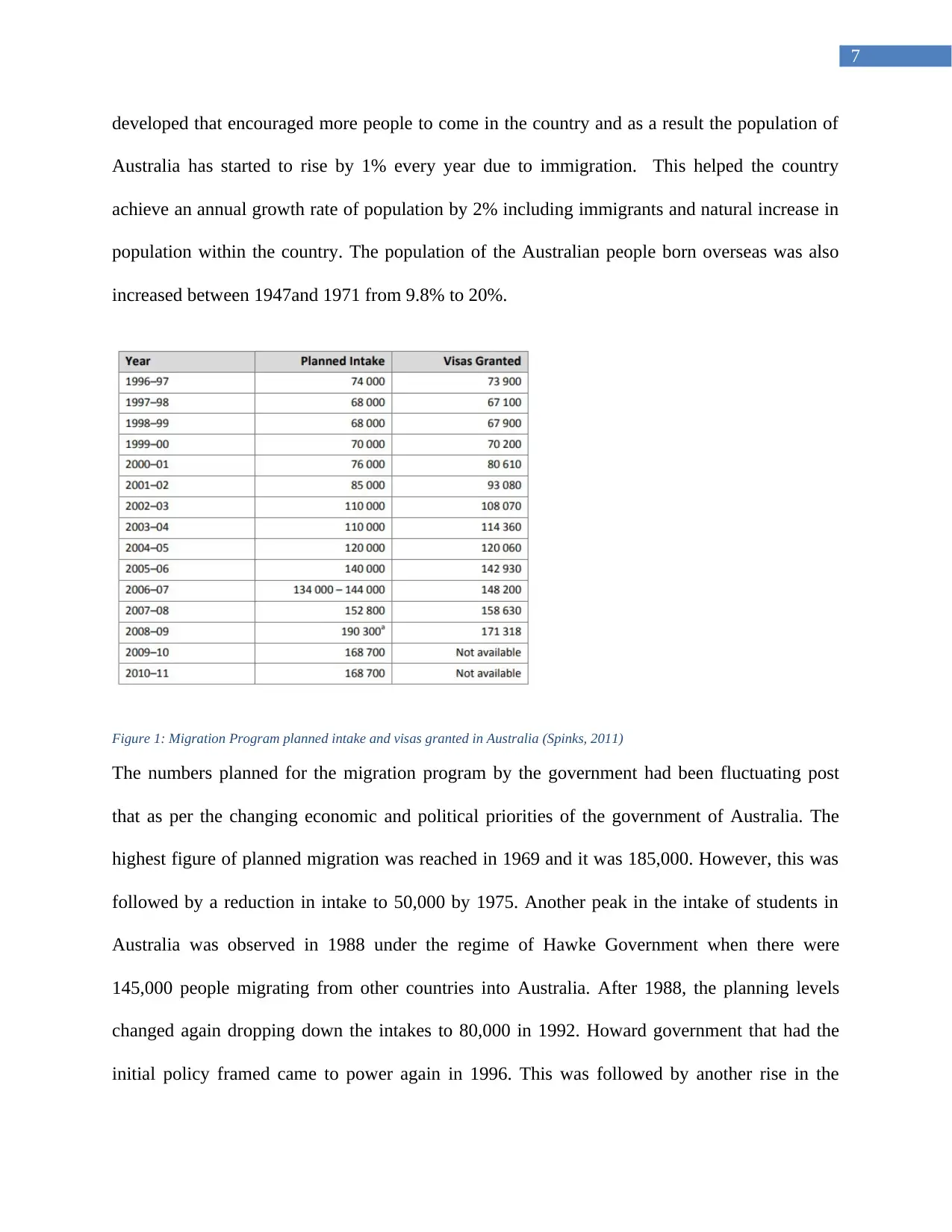
7
developed that encouraged more people to come in the country and as a result the population of
Australia has started to rise by 1% every year due to immigration. This helped the country
achieve an annual growth rate of population by 2% including immigrants and natural increase in
population within the country. The population of the Australian people born overseas was also
increased between 1947and 1971 from 9.8% to 20%.
Figure 1: Migration Program planned intake and visas granted in Australia (Spinks, 2011)
The numbers planned for the migration program by the government had been fluctuating post
that as per the changing economic and political priorities of the government of Australia. The
highest figure of planned migration was reached in 1969 and it was 185,000. However, this was
followed by a reduction in intake to 50,000 by 1975. Another peak in the intake of students in
Australia was observed in 1988 under the regime of Hawke Government when there were
145,000 people migrating from other countries into Australia. After 1988, the planning levels
changed again dropping down the intakes to 80,000 in 1992. Howard government that had the
initial policy framed came to power again in 1996. This was followed by another rise in the
developed that encouraged more people to come in the country and as a result the population of
Australia has started to rise by 1% every year due to immigration. This helped the country
achieve an annual growth rate of population by 2% including immigrants and natural increase in
population within the country. The population of the Australian people born overseas was also
increased between 1947and 1971 from 9.8% to 20%.
Figure 1: Migration Program planned intake and visas granted in Australia (Spinks, 2011)
The numbers planned for the migration program by the government had been fluctuating post
that as per the changing economic and political priorities of the government of Australia. The
highest figure of planned migration was reached in 1969 and it was 185,000. However, this was
followed by a reduction in intake to 50,000 by 1975. Another peak in the intake of students in
Australia was observed in 1988 under the regime of Hawke Government when there were
145,000 people migrating from other countries into Australia. After 1988, the planning levels
changed again dropping down the intakes to 80,000 in 1992. Howard government that had the
initial policy framed came to power again in 1996. This was followed by another rise in the
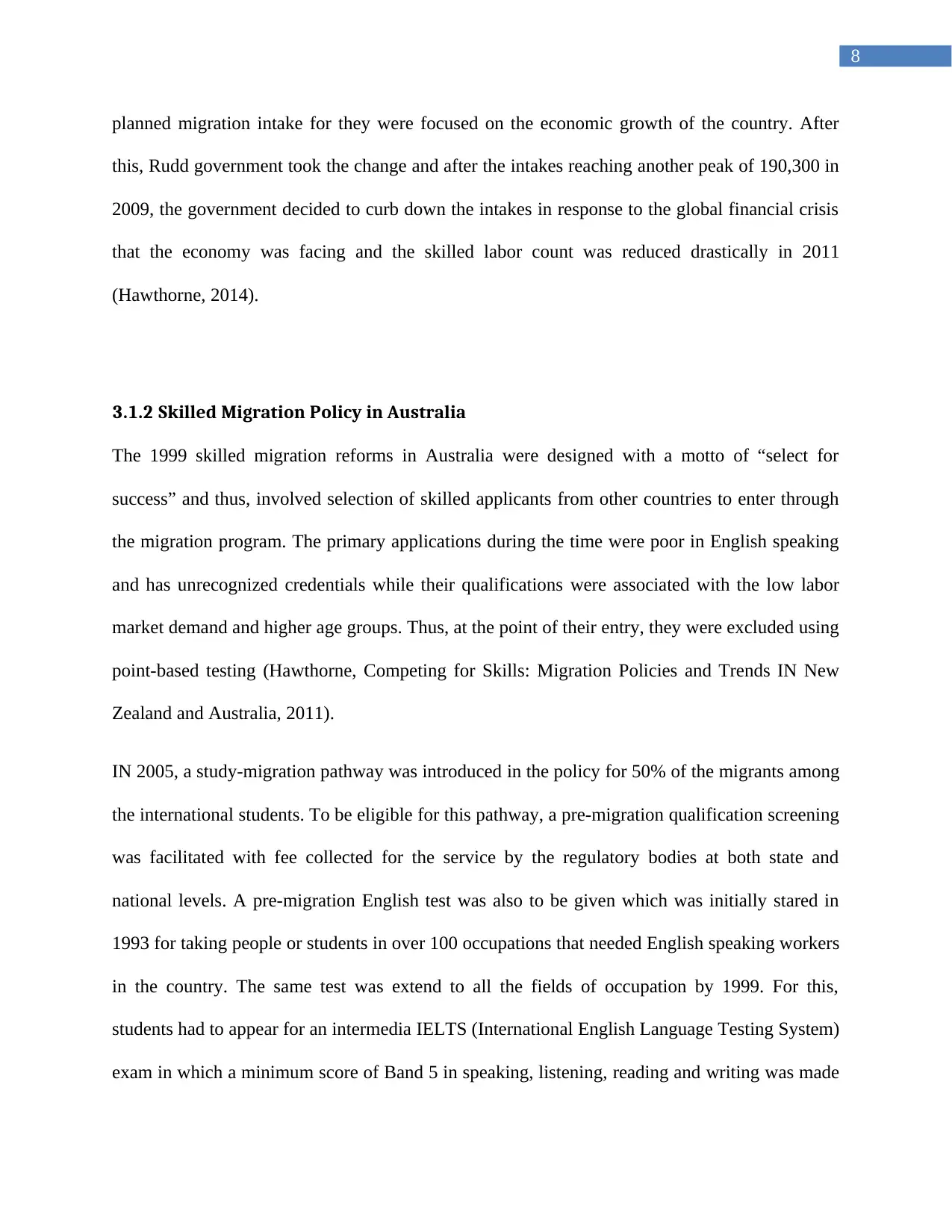
8
planned migration intake for they were focused on the economic growth of the country. After
this, Rudd government took the change and after the intakes reaching another peak of 190,300 in
2009, the government decided to curb down the intakes in response to the global financial crisis
that the economy was facing and the skilled labor count was reduced drastically in 2011
(Hawthorne, 2014).
3.1.2 Skilled Migration Policy in Australia
The 1999 skilled migration reforms in Australia were designed with a motto of “select for
success” and thus, involved selection of skilled applicants from other countries to enter through
the migration program. The primary applications during the time were poor in English speaking
and has unrecognized credentials while their qualifications were associated with the low labor
market demand and higher age groups. Thus, at the point of their entry, they were excluded using
point-based testing (Hawthorne, Competing for Skills: Migration Policies and Trends IN New
Zealand and Australia, 2011).
IN 2005, a study-migration pathway was introduced in the policy for 50% of the migrants among
the international students. To be eligible for this pathway, a pre-migration qualification screening
was facilitated with fee collected for the service by the regulatory bodies at both state and
national levels. A pre-migration English test was also to be given which was initially stared in
1993 for taking people or students in over 100 occupations that needed English speaking workers
in the country. The same test was extend to all the fields of occupation by 1999. For this,
students had to appear for an intermedia IELTS (International English Language Testing System)
exam in which a minimum score of Band 5 in speaking, listening, reading and writing was made
planned migration intake for they were focused on the economic growth of the country. After
this, Rudd government took the change and after the intakes reaching another peak of 190,300 in
2009, the government decided to curb down the intakes in response to the global financial crisis
that the economy was facing and the skilled labor count was reduced drastically in 2011
(Hawthorne, 2014).
3.1.2 Skilled Migration Policy in Australia
The 1999 skilled migration reforms in Australia were designed with a motto of “select for
success” and thus, involved selection of skilled applicants from other countries to enter through
the migration program. The primary applications during the time were poor in English speaking
and has unrecognized credentials while their qualifications were associated with the low labor
market demand and higher age groups. Thus, at the point of their entry, they were excluded using
point-based testing (Hawthorne, Competing for Skills: Migration Policies and Trends IN New
Zealand and Australia, 2011).
IN 2005, a study-migration pathway was introduced in the policy for 50% of the migrants among
the international students. To be eligible for this pathway, a pre-migration qualification screening
was facilitated with fee collected for the service by the regulatory bodies at both state and
national levels. A pre-migration English test was also to be given which was initially stared in
1993 for taking people or students in over 100 occupations that needed English speaking workers
in the country. The same test was extend to all the fields of occupation by 1999. For this,
students had to appear for an intermedia IELTS (International English Language Testing System)
exam in which a minimum score of Band 5 in speaking, listening, reading and writing was made
⊘ This is a preview!⊘
Do you want full access?
Subscribe today to unlock all pages.

Trusted by 1+ million students worldwide
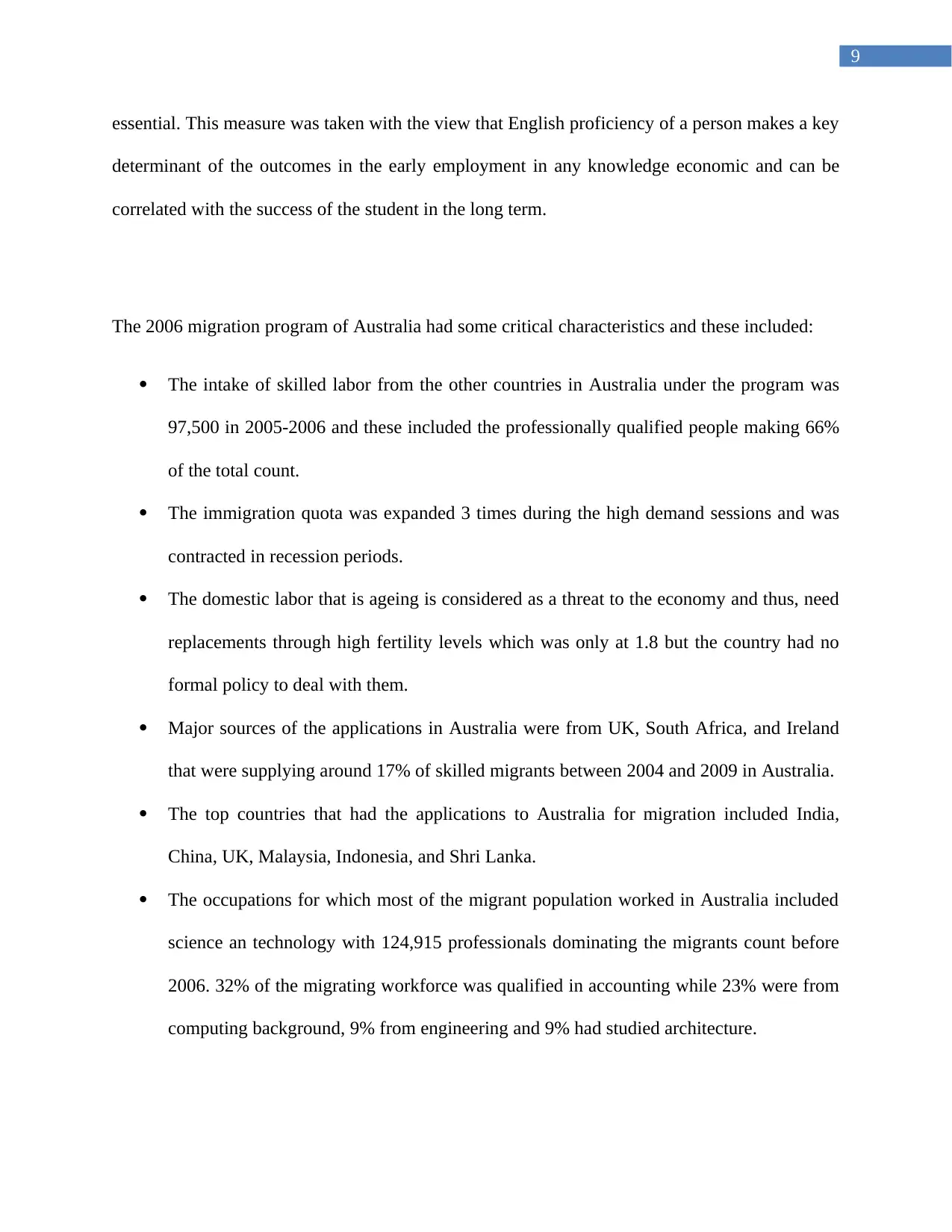
9
essential. This measure was taken with the view that English proficiency of a person makes a key
determinant of the outcomes in the early employment in any knowledge economic and can be
correlated with the success of the student in the long term.
The 2006 migration program of Australia had some critical characteristics and these included:
The intake of skilled labor from the other countries in Australia under the program was
97,500 in 2005-2006 and these included the professionally qualified people making 66%
of the total count.
The immigration quota was expanded 3 times during the high demand sessions and was
contracted in recession periods.
The domestic labor that is ageing is considered as a threat to the economy and thus, need
replacements through high fertility levels which was only at 1.8 but the country had no
formal policy to deal with them.
Major sources of the applications in Australia were from UK, South Africa, and Ireland
that were supplying around 17% of skilled migrants between 2004 and 2009 in Australia.
The top countries that had the applications to Australia for migration included India,
China, UK, Malaysia, Indonesia, and Shri Lanka.
The occupations for which most of the migrant population worked in Australia included
science an technology with 124,915 professionals dominating the migrants count before
2006. 32% of the migrating workforce was qualified in accounting while 23% were from
computing background, 9% from engineering and 9% had studied architecture.
essential. This measure was taken with the view that English proficiency of a person makes a key
determinant of the outcomes in the early employment in any knowledge economic and can be
correlated with the success of the student in the long term.
The 2006 migration program of Australia had some critical characteristics and these included:
The intake of skilled labor from the other countries in Australia under the program was
97,500 in 2005-2006 and these included the professionally qualified people making 66%
of the total count.
The immigration quota was expanded 3 times during the high demand sessions and was
contracted in recession periods.
The domestic labor that is ageing is considered as a threat to the economy and thus, need
replacements through high fertility levels which was only at 1.8 but the country had no
formal policy to deal with them.
Major sources of the applications in Australia were from UK, South Africa, and Ireland
that were supplying around 17% of skilled migrants between 2004 and 2009 in Australia.
The top countries that had the applications to Australia for migration included India,
China, UK, Malaysia, Indonesia, and Shri Lanka.
The occupations for which most of the migrant population worked in Australia included
science an technology with 124,915 professionals dominating the migrants count before
2006. 32% of the migrating workforce was qualified in accounting while 23% were from
computing background, 9% from engineering and 9% had studied architecture.
Paraphrase This Document
Need a fresh take? Get an instant paraphrase of this document with our AI Paraphraser
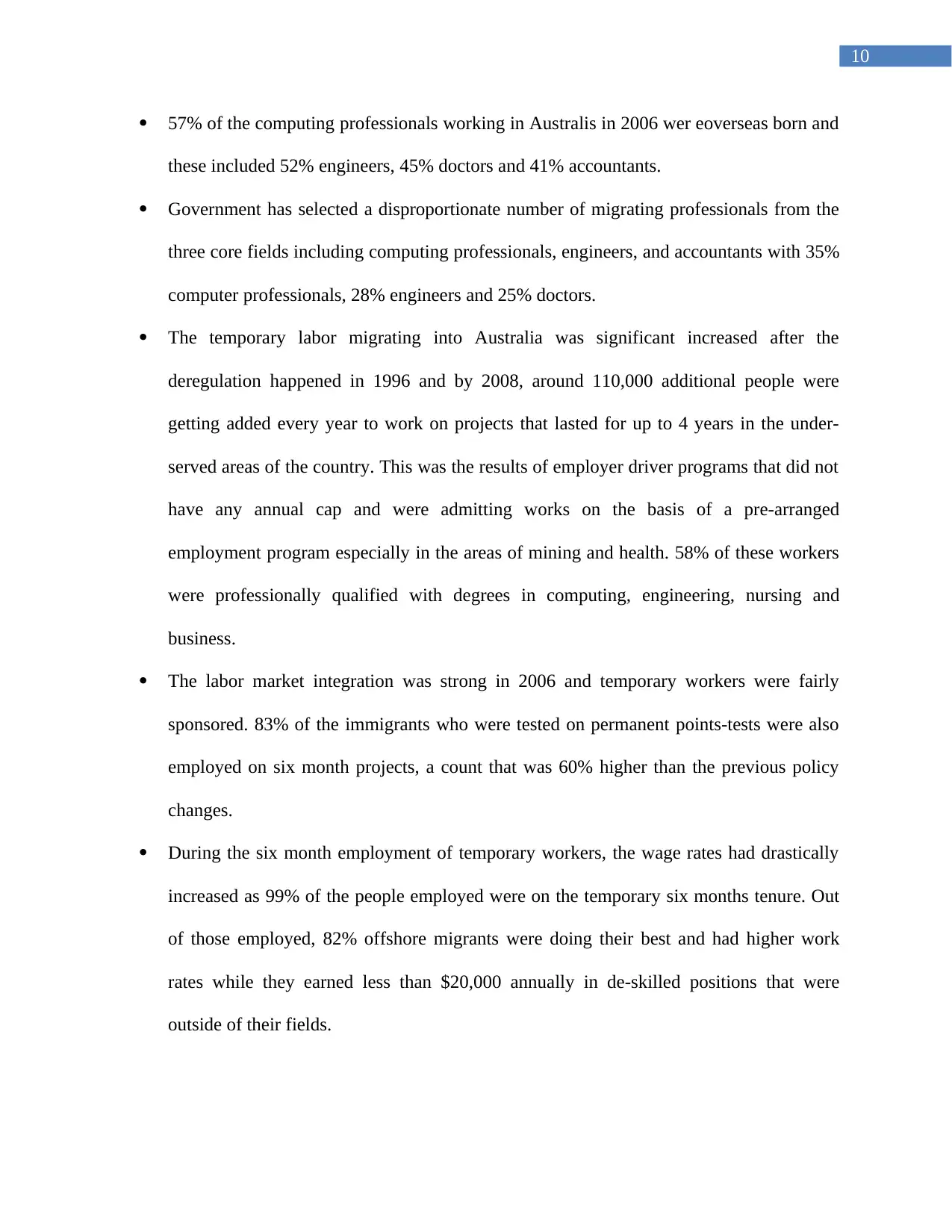
10
57% of the computing professionals working in Australis in 2006 wer eoverseas born and
these included 52% engineers, 45% doctors and 41% accountants.
Government has selected a disproportionate number of migrating professionals from the
three core fields including computing professionals, engineers, and accountants with 35%
computer professionals, 28% engineers and 25% doctors.
The temporary labor migrating into Australia was significant increased after the
deregulation happened in 1996 and by 2008, around 110,000 additional people were
getting added every year to work on projects that lasted for up to 4 years in the under-
served areas of the country. This was the results of employer driver programs that did not
have any annual cap and were admitting works on the basis of a pre-arranged
employment program especially in the areas of mining and health. 58% of these workers
were professionally qualified with degrees in computing, engineering, nursing and
business.
The labor market integration was strong in 2006 and temporary workers were fairly
sponsored. 83% of the immigrants who were tested on permanent points-tests were also
employed on six month projects, a count that was 60% higher than the previous policy
changes.
During the six month employment of temporary workers, the wage rates had drastically
increased as 99% of the people employed were on the temporary six months tenure. Out
of those employed, 82% offshore migrants were doing their best and had higher work
rates while they earned less than $20,000 annually in de-skilled positions that were
outside of their fields.
57% of the computing professionals working in Australis in 2006 wer eoverseas born and
these included 52% engineers, 45% doctors and 41% accountants.
Government has selected a disproportionate number of migrating professionals from the
three core fields including computing professionals, engineers, and accountants with 35%
computer professionals, 28% engineers and 25% doctors.
The temporary labor migrating into Australia was significant increased after the
deregulation happened in 1996 and by 2008, around 110,000 additional people were
getting added every year to work on projects that lasted for up to 4 years in the under-
served areas of the country. This was the results of employer driver programs that did not
have any annual cap and were admitting works on the basis of a pre-arranged
employment program especially in the areas of mining and health. 58% of these workers
were professionally qualified with degrees in computing, engineering, nursing and
business.
The labor market integration was strong in 2006 and temporary workers were fairly
sponsored. 83% of the immigrants who were tested on permanent points-tests were also
employed on six month projects, a count that was 60% higher than the previous policy
changes.
During the six month employment of temporary workers, the wage rates had drastically
increased as 99% of the people employed were on the temporary six months tenure. Out
of those employed, 82% offshore migrants were doing their best and had higher work
rates while they earned less than $20,000 annually in de-skilled positions that were
outside of their fields.
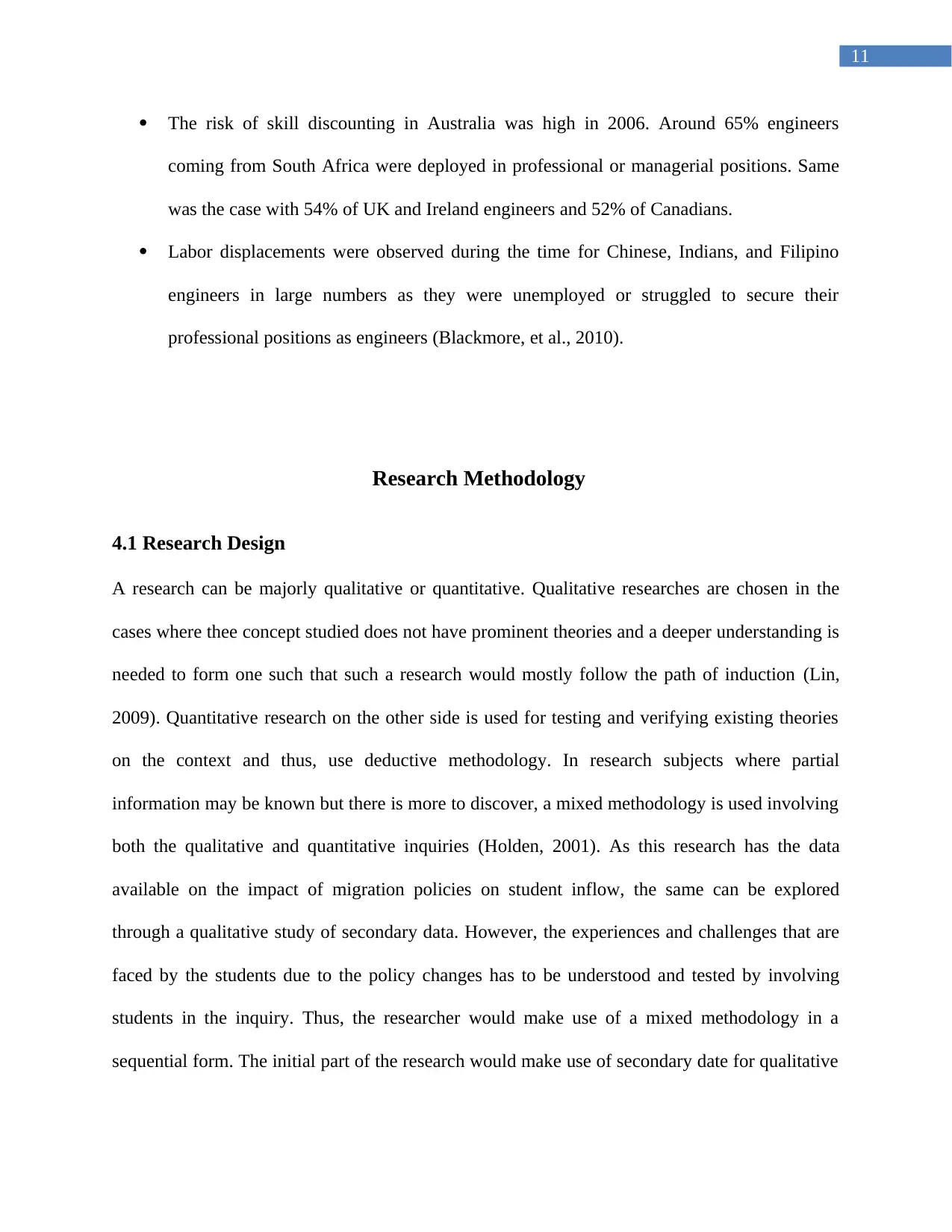
11
The risk of skill discounting in Australia was high in 2006. Around 65% engineers
coming from South Africa were deployed in professional or managerial positions. Same
was the case with 54% of UK and Ireland engineers and 52% of Canadians.
Labor displacements were observed during the time for Chinese, Indians, and Filipino
engineers in large numbers as they were unemployed or struggled to secure their
professional positions as engineers (Blackmore, et al., 2010).
Research Methodology
4.1 Research Design
A research can be majorly qualitative or quantitative. Qualitative researches are chosen in the
cases where thee concept studied does not have prominent theories and a deeper understanding is
needed to form one such that such a research would mostly follow the path of induction (Lin,
2009). Quantitative research on the other side is used for testing and verifying existing theories
on the context and thus, use deductive methodology. In research subjects where partial
information may be known but there is more to discover, a mixed methodology is used involving
both the qualitative and quantitative inquiries (Holden, 2001). As this research has the data
available on the impact of migration policies on student inflow, the same can be explored
through a qualitative study of secondary data. However, the experiences and challenges that are
faced by the students due to the policy changes has to be understood and tested by involving
students in the inquiry. Thus, the researcher would make use of a mixed methodology in a
sequential form. The initial part of the research would make use of secondary date for qualitative
The risk of skill discounting in Australia was high in 2006. Around 65% engineers
coming from South Africa were deployed in professional or managerial positions. Same
was the case with 54% of UK and Ireland engineers and 52% of Canadians.
Labor displacements were observed during the time for Chinese, Indians, and Filipino
engineers in large numbers as they were unemployed or struggled to secure their
professional positions as engineers (Blackmore, et al., 2010).
Research Methodology
4.1 Research Design
A research can be majorly qualitative or quantitative. Qualitative researches are chosen in the
cases where thee concept studied does not have prominent theories and a deeper understanding is
needed to form one such that such a research would mostly follow the path of induction (Lin,
2009). Quantitative research on the other side is used for testing and verifying existing theories
on the context and thus, use deductive methodology. In research subjects where partial
information may be known but there is more to discover, a mixed methodology is used involving
both the qualitative and quantitative inquiries (Holden, 2001). As this research has the data
available on the impact of migration policies on student inflow, the same can be explored
through a qualitative study of secondary data. However, the experiences and challenges that are
faced by the students due to the policy changes has to be understood and tested by involving
students in the inquiry. Thus, the researcher would make use of a mixed methodology in a
sequential form. The initial part of the research would make use of secondary date for qualitative
⊘ This is a preview!⊘
Do you want full access?
Subscribe today to unlock all pages.

Trusted by 1+ million students worldwide
1 out of 18
Related Documents
Your All-in-One AI-Powered Toolkit for Academic Success.
+13062052269
info@desklib.com
Available 24*7 on WhatsApp / Email
![[object Object]](/_next/static/media/star-bottom.7253800d.svg)
Unlock your academic potential
Copyright © 2020–2025 A2Z Services. All Rights Reserved. Developed and managed by ZUCOL.




